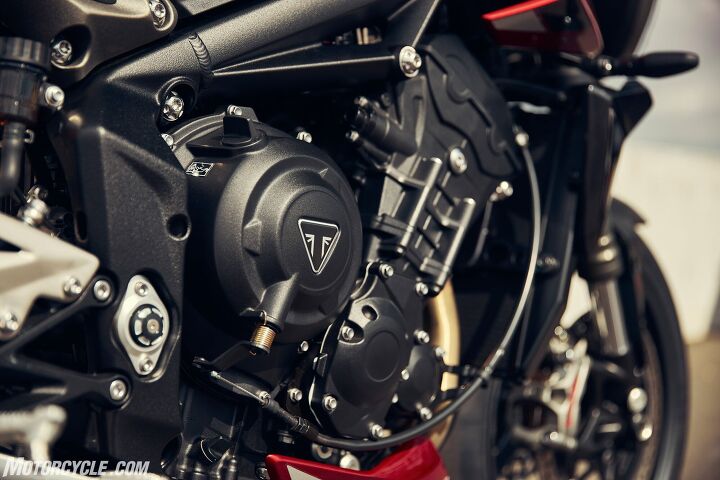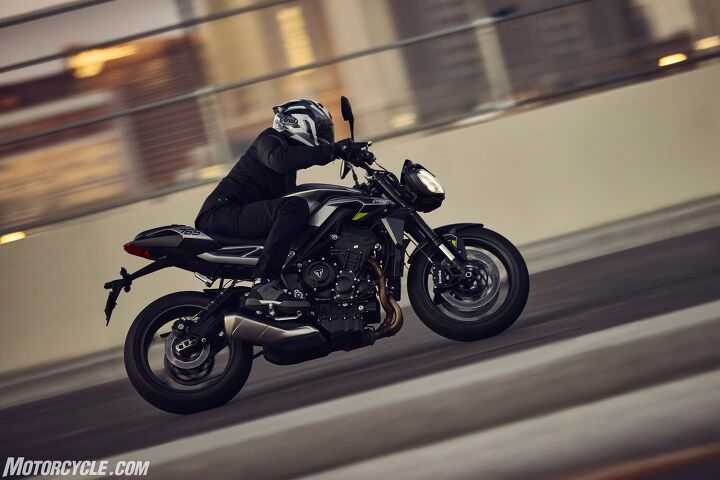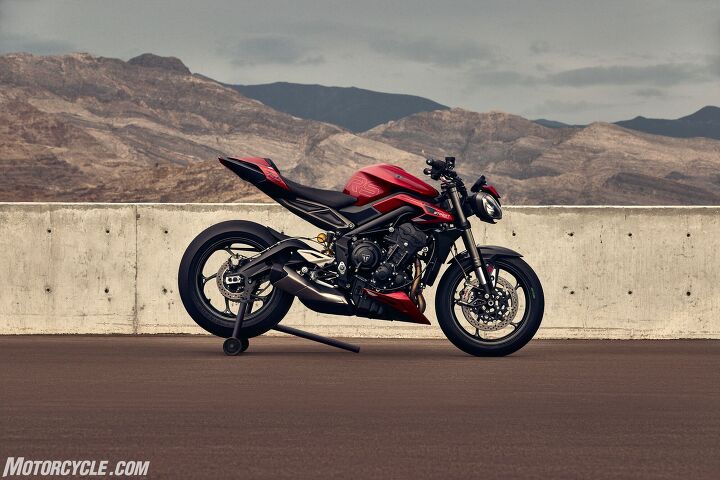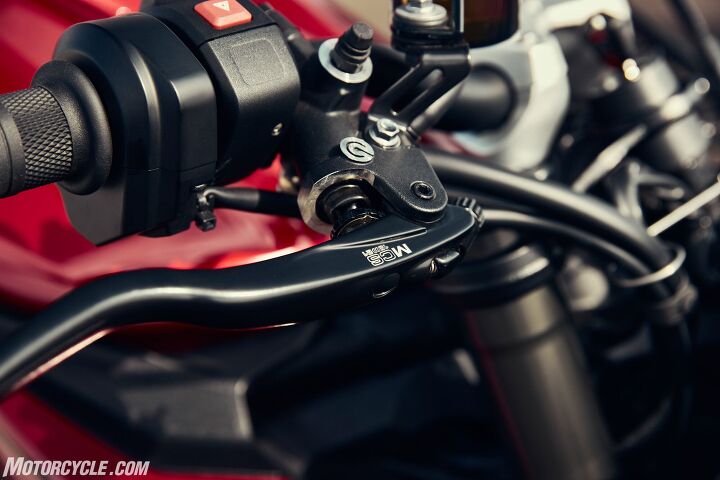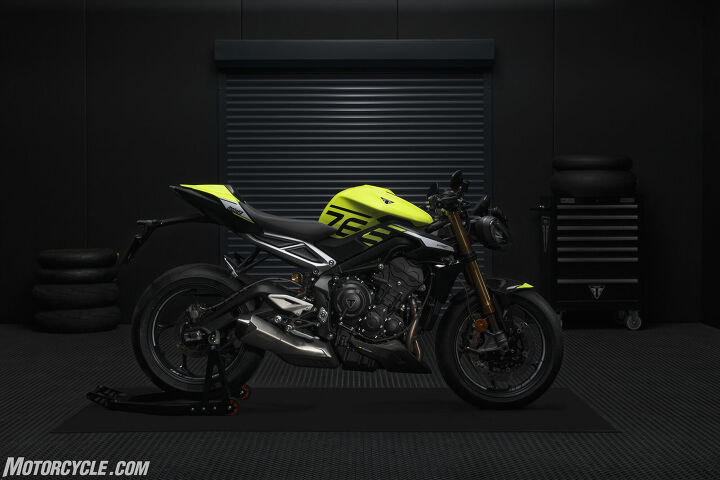Motorsports Racing News & Blog Articles
Triumph Announce New Street Triple Lineup For 2023
Triumph has announced a shakeup to its ever-popular Street Triple range today, introducing not one, but three evolutions to the family, creating what it says is “the most powerful Street Triple range ever.” Building off the success it has forged by being the sole engine supplier for the Moto2 racing category, Triumph now introduces the Street Triple R, Street Triple RS, and the Street Triple 765 Moto2 Edition – the latter of which will be relegated to just 765 units worldwide.
Unlike Honda, whose CBR600RR engine was the basis of the Moto2 category during its birth, Triumph has used the racing category to advance the 765cc three-cylinder engine shared between the race bikes and production bikes. The latest Street Triple range is the beneficiary of those advancements.
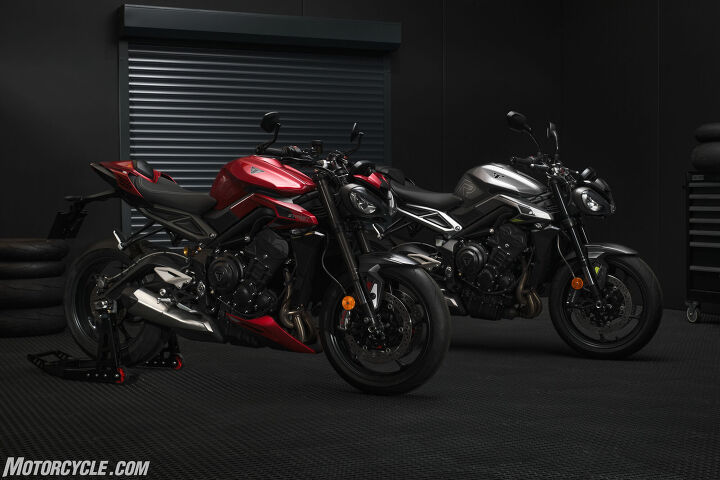
Formerly the top of the range, the Street Triple 765 R (right) is now the base model. The Street Triple 765 RS is now the mass-produced performance model.
All three models will get the updated 765cc Triple, which features new pistons, connecting rods, and wrist pins (aka gudgeon pins if you’re British) on the bottom end. The combustion chambers are revised for increased cylinder pressure limits, since the compression ratio has now gone up 4.7%, from 12.65:1 to 13.25:1. New valves and higher lift camshafts round out the top end changes. The R, which is now the base model, peaks at a claimed 118 hp at 11,500 rpm, while the RS and Moto2 top out at a claimed 128 hp at 12,000 rpm. Peak torque is 59 lb-ft at 9,500 rpm, with a notable increase starting at 7,500 rpm compared to the previous model.
Triumph says all six internal gear ratios, as well as the final drive ratio, have been changed compared to the outgoing model for shorter overall gearing. What you should feel from the saddle is faster acceleration (likely at the expense of top speed) in every gear, aided by an up-and-down quickshifter on all three models.
From a tech standpoint, a Continental IMU is fitted to all three models, allowing for optimized cornering ABS and a more refined traction control system (which can also be turned off). As part of the update, the riding modes (four on the R, five on the RS and Moto2) have been refined as well with what Triumph calls, “more dynamic throttle maps.” As part of these new maps, the ABS thresholds are tailored to each mode, giving the rider more or less sensitivity depending on the mode. For the RS and Moto2, the Track riding mode is equipped with a minimally invasive ABS setting.
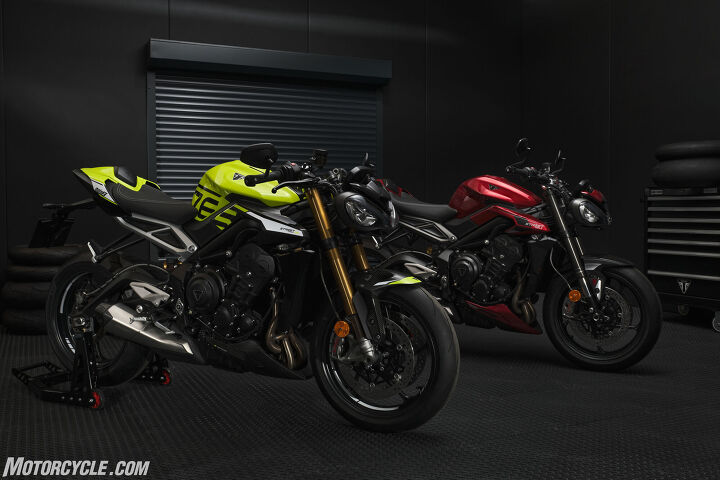
One-upping the Street Triple 765 RS is the Moto2 Edition (left), with clip-on bars and Öhlins suspension at both ends.
Visually, the Street Triple range gets a new look that’s sharper and more aggressive, but still very familiar to the original Street Triple from 2007. The new 3.96-gallon fuel tank is smaller than the previous 4.6-gallon tank, but has integrated side panels with an angular design that integrates with the radiator cowls. This flow is continued with the headlight surround that also incorporates the air intake. There’s also a new color-matched bellypan for RS models (available as an option on the R).
At the back, the upswept design gives the Street Triples a nose-down, aggressive attitude which complements well with the new, freer-flowing exhaust, which itself is redesigned.
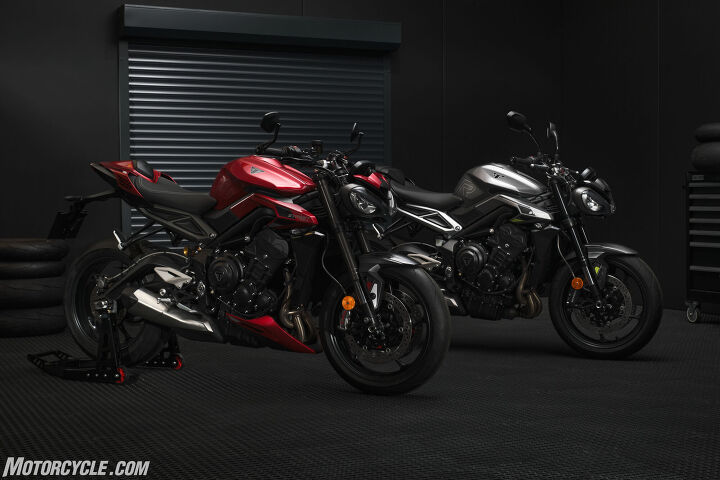
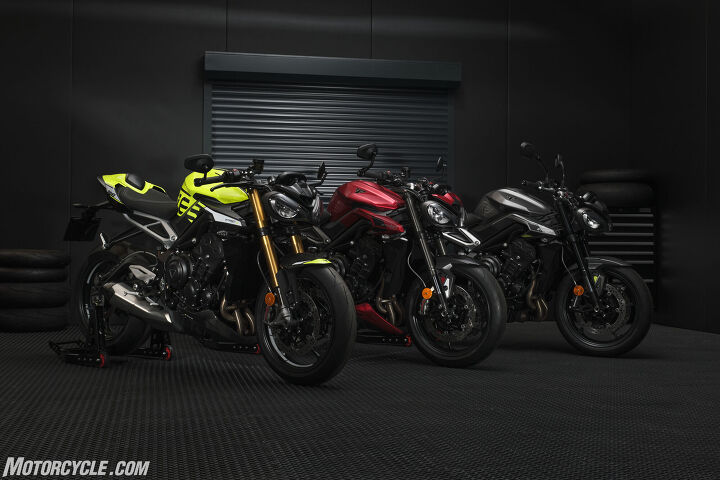
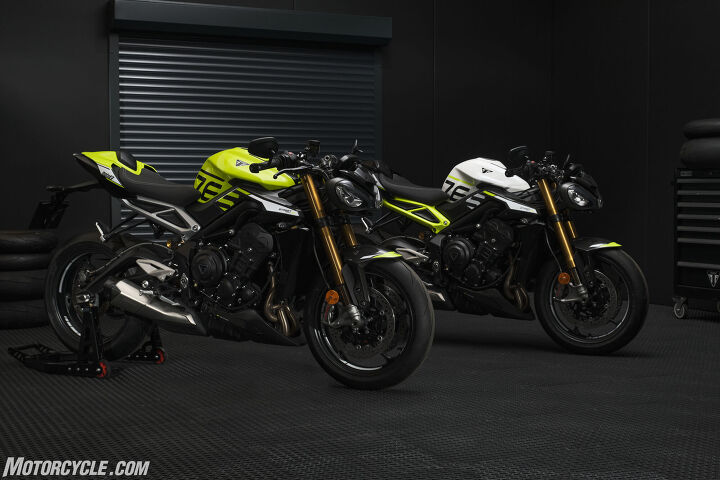
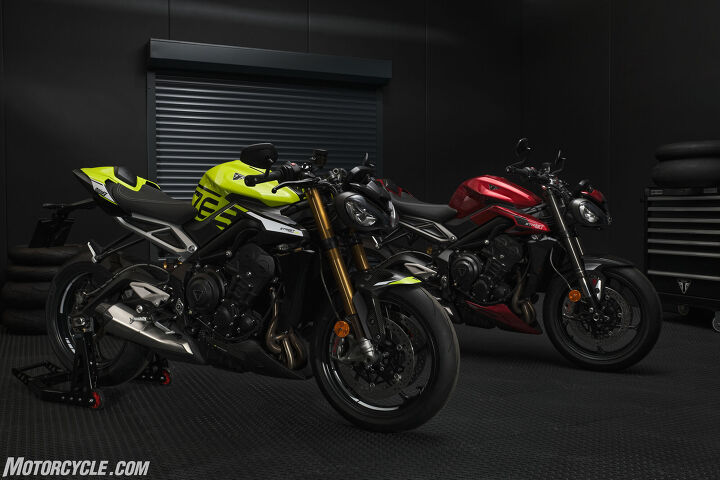
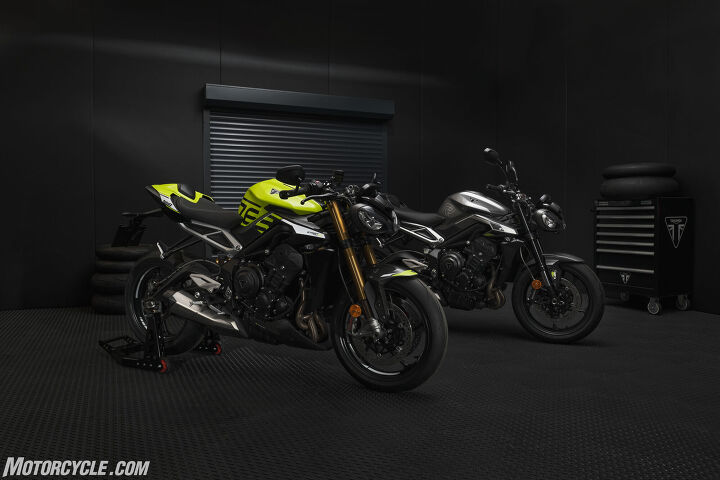
All three models have a 6,000-mile (10,000 km) service interval, two years unlimited mileage warranty, and two years of Roadside Assistance. For the US and Canada, bikes will be available starting in Spring 2023, making these technically model year 2024 motorcycles. Semantics, we know, but a point worth mentioning.
As far as the individual models are concerned, here’s what you can expect from each:
Street Triple 765 R
It doesn’t seem too long ago that the R model was the highest performing in the Street Triple family. With it now serving as the base, it goes to show how far the line has gone. As mentioned before, the R model gets the same engine as the RS and Moto2 editions, but with a lower power output of 118 horses.
Being the base model, suspension components are not at the same level as the other models, but are still no less performance-oriented. Says Stuart Wood, Head of Engineering at Triumph, “The Street Triple R has Showa suspension front and rear with 41mm diameter, USD Separate Function Big Piston front forks with 4.5 inches (115mm) of stroke and a piggyback reservoir rear suspension unit giving 5.2 inches (133mm) of rear wheel travel. Both ends are fully adjustable for spring preload, compression damping, and rebound damping. The Street Triple R is set up with a 32.5-inch (826mm) seat height. This gives a headstock angle of 23.7 degrees and trail of 97.8mm. These are slightly steeper and shorter than the outgoing street Triple RS with the objective of further improving agility and precision.
Braking is handled by Brembo on all three bikes, but the R is fitted with M4.32 radial monoblock calipers mated to 310mm rotors.
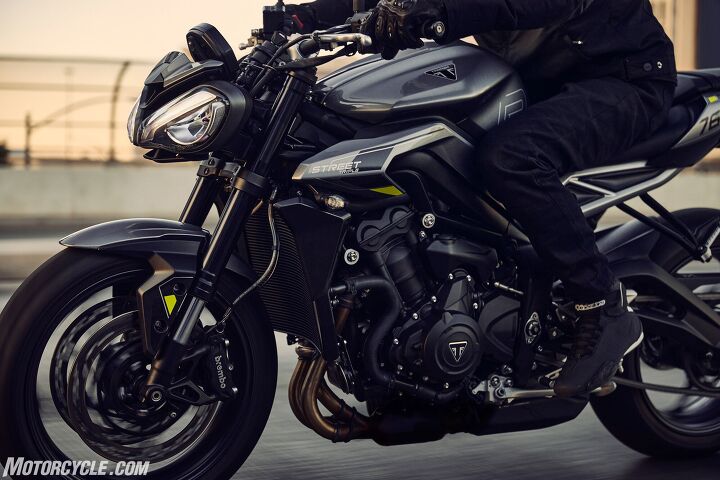
The easiest way to spot the R model is to look for the Brembo M4.32 calipers. The RS and Moto2 wear Stylemas.
Ergonomically, the R and RS models get new, 12mm wider handlebars for more leverage to bend the bike to your will. That comes out to half an inch wider for those of us in the States, and while it may not sound like much, when combined with the rest of the changes to the bike it should help keep the Street Triple as one of the top handling motorcycles in the category. Seat height remains the same at 32.5 inches – the same as the outgoing Street Triple R.
On the tech front, the R model gets four ride modes: Road, Rain, Sport, and Rider-configurable, which allows the user to customize some of the settings to have, say, the Sport power levels with the Rain ABS and/or traction control settings. All of the R model’s information is shown to you on a TFT display, though it’s unsurprisingly smaller than the one on the RS and Moto2.
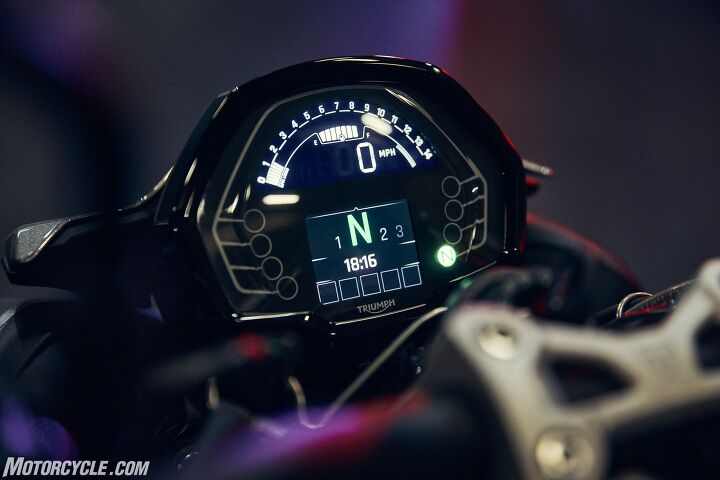
The other feature exclusive to the R model is the smaller gauge display. The RS and Moto2 get larger TFT screens.
Lastly, the Street Triple R will come fitted with Continental ContiRoad tires. The Street Triple 765 R is available in two colors: Silver Ice with Storm Grey and Yellow graphics or Crystal White with Storm Grey and Lithium Flame graphics.
The Street Triple R starts at $9,995.
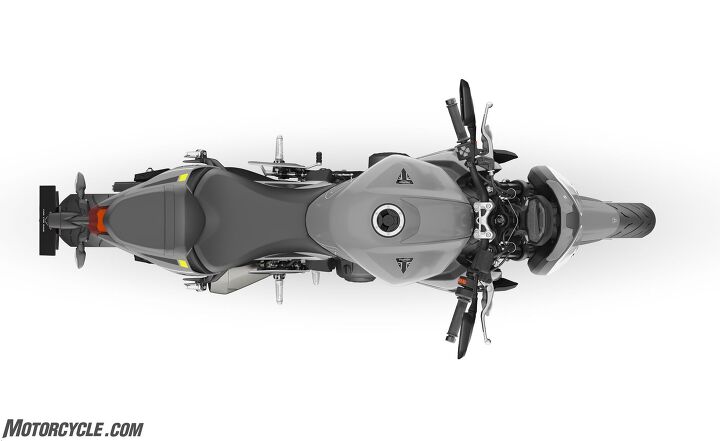
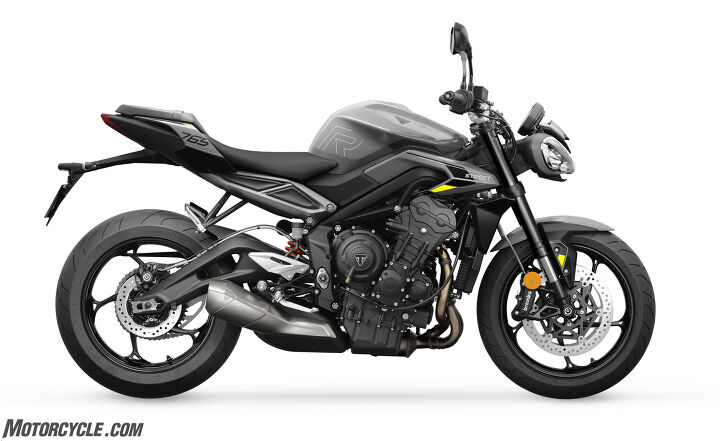
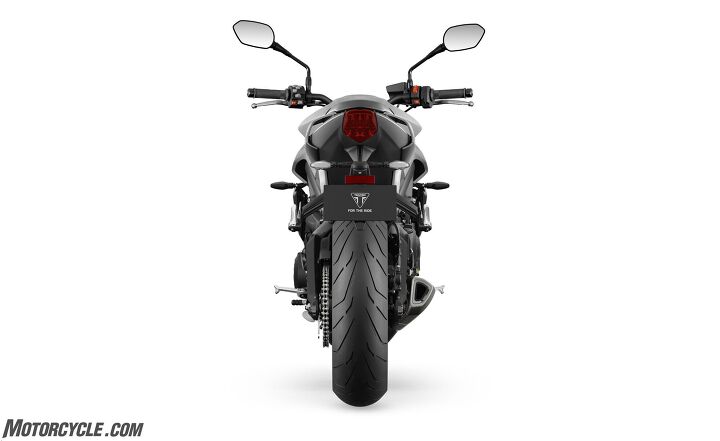
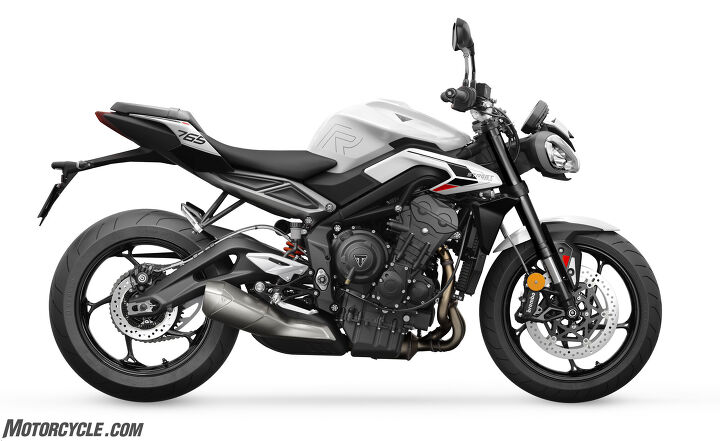
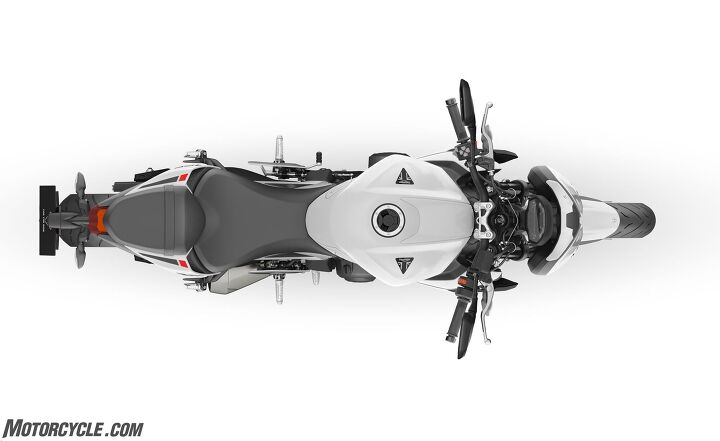
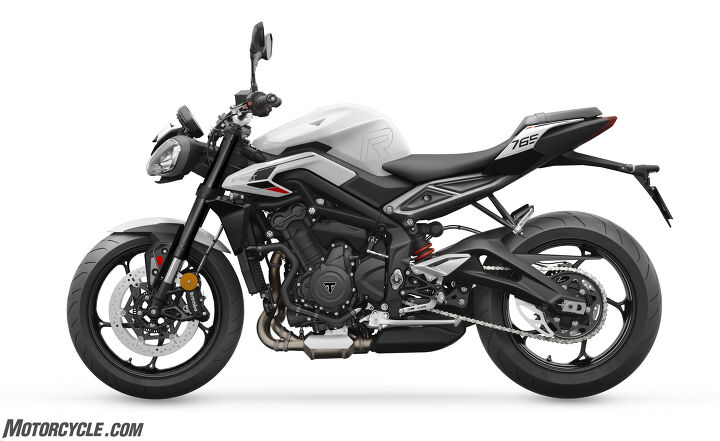
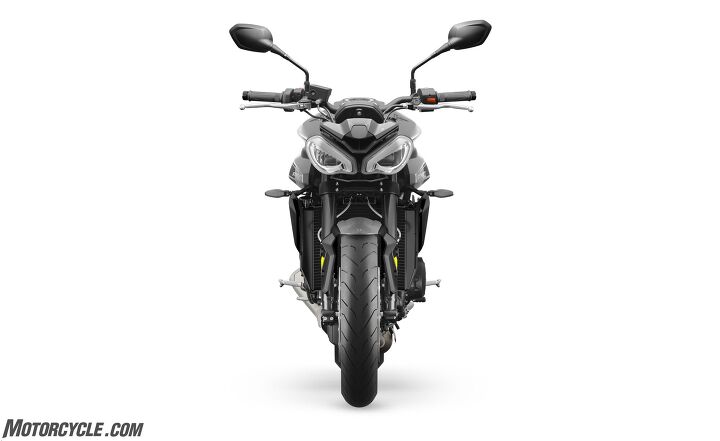
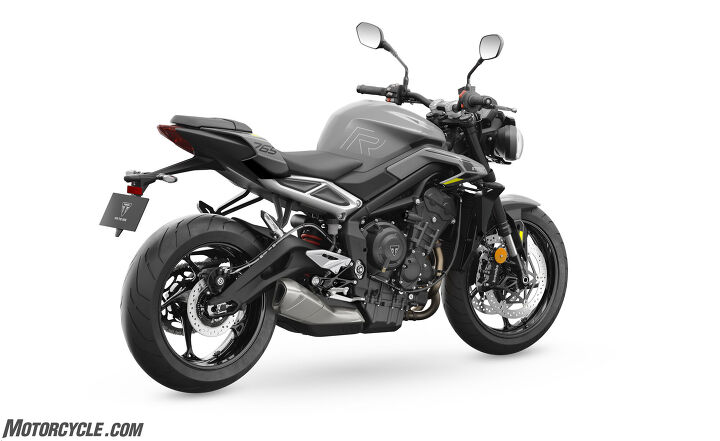
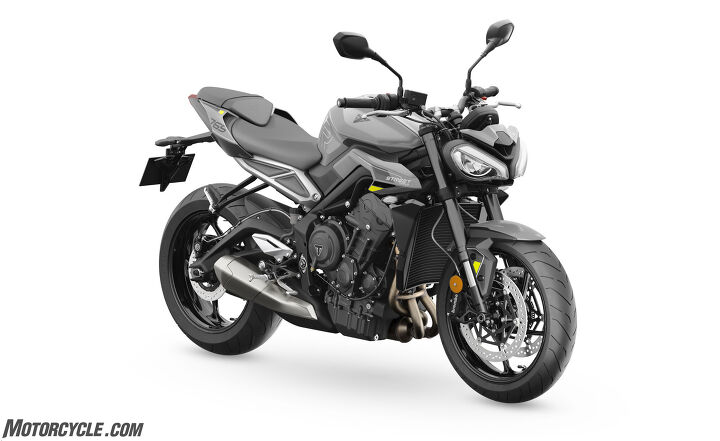
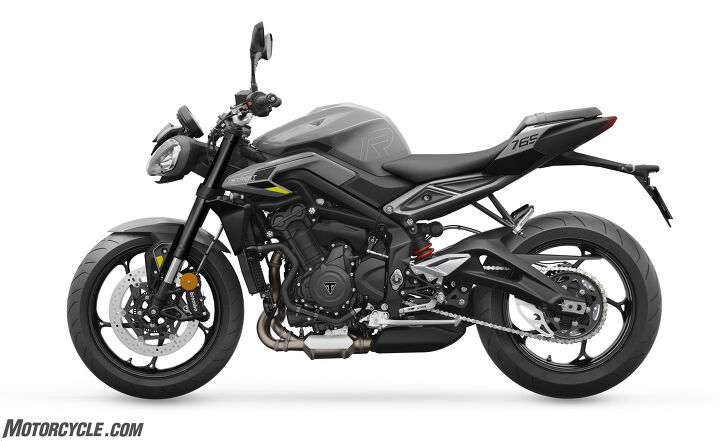

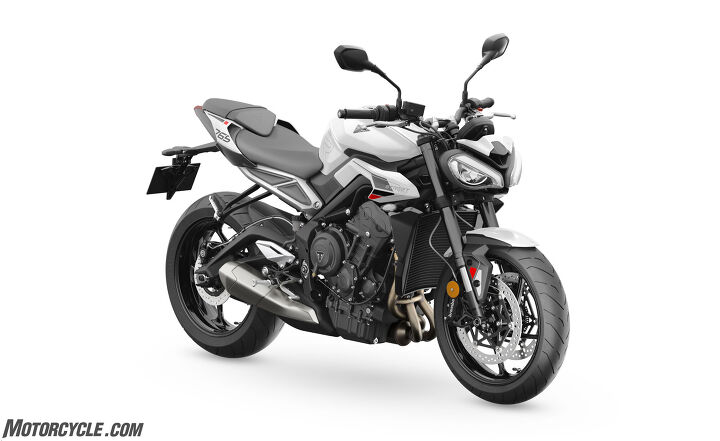
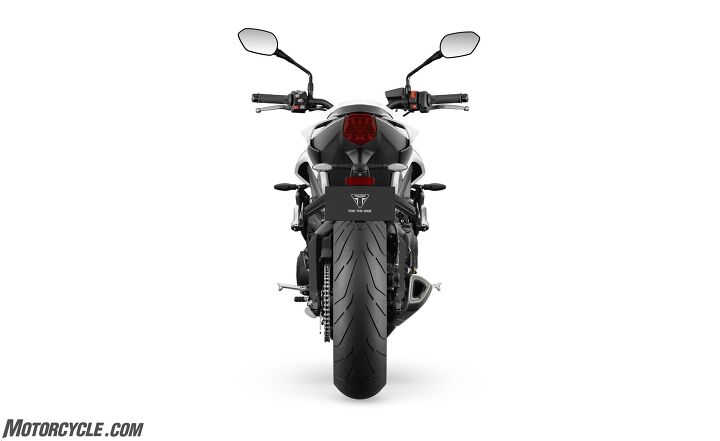

Street Triple 765 RS
Things start to get a little more spicy with the Street Triple 765 RS. It gets all the upgrades mentioned already, and in addition to the features you get on the R model, the RS unleashes the 765 engine’s full potential of 128 horsepower – a number Triumph claims is highest in the class.
Another significant difference between the RS and the R is the revised steering geometry for the RS, achieved with different suspension than the R. Here’s Wood again, “The Street Triple RS has the higher spec Showa, 41mm diameter, USD Big Piston forks with 4.5 inches (115mm) of stroke and an Öhlins STX40, piggyback reservoir rear suspension unit with 5.2 inches (131mm) of rear wheel travel. Both ends are fully adjustable for spring preload, compression damping and rebound damping. The Street Triple RS is set up with taller rear suspension and a 32.9-inch (836mm) seat height. This gives a headstock angle of 23.2 degrees and trail of 96.9mm. These dimensions are even steeper and shorter further improving agility and precision.
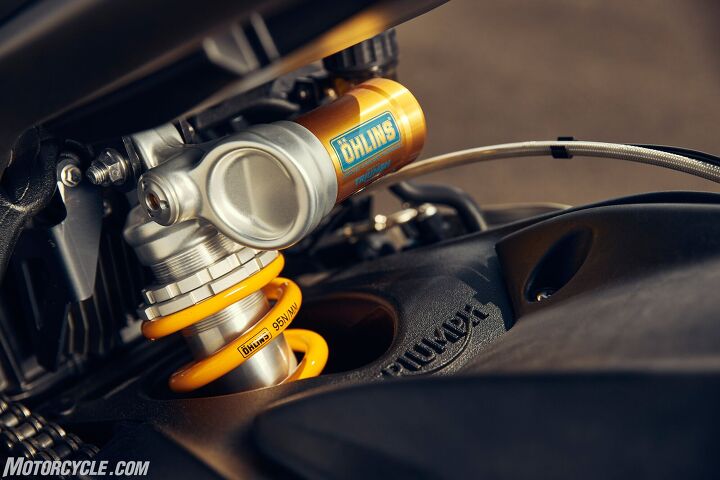
Triumph partnered with Öhlins for suspension components, but curiously, didn’t equip the RS (or Moto2) with a TTX shock.
For all three bikes, if the standard seat height is too high, there’s an accessory low seat that drops the height 1.1 inches (28mm). If you want to bring the seat even lower on the RS or Moto2 models, then there’s a lowering linkage (that must be installed by a dealer), capable of lowering the two bikes another 0.39 inches (10mm), if needed.
Other than the suspension difference, there’s another difference with the brakes, as the RS replaces the M4.32 calipers seen on the R for Brembo’s Stylema calipers. A MCS master cylinder is also fitted on the RS for more refined brake control. All three bikes get linked braking as well, with a little bit of rear brake applied when you use the front – though the opposite is not true. When using only the rear brake the front is not applied.
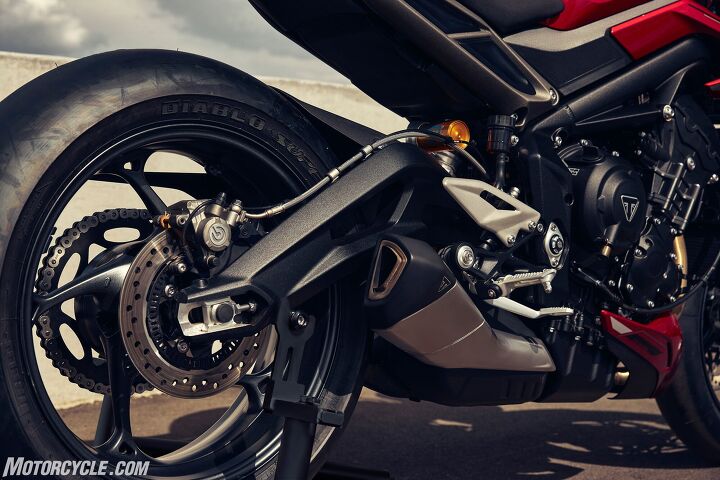
Rear suspension geometry is higher than before, giving the bike a steeper rake angle for sharper steering.
As hinted at before, the RS gets the same four riding modes as the R model as well as a fifth mode, Track. In Track mode the rider aids are as unobtrusive as possible while still hanging around in the background to give some assistance if you really screw things up.
Also unlike the R model, the RS gets a 5-inch TFT display to view the bike’s information, along with Triumph’s joystick and switch cube seen on other models. The MyTriumph connectivity system is pre-enabled, meaning that Street Triple owners can access turn-by-turn navigation, phone control and music operation via the accessory-fit Bluetooth module and free My Triumph app. Lastly, there’s also a lap timer, in case you feel the need to audition for a Moto2 seat at your local trackday.
For the Street Triple 765 RS, there’s a choice of three paint schemes; Silver Ice with Baja Orange and Storm Grey graphics, Carnival Red with Carbon Black and Aluminum Silver graphics or Cosmic Yellow with Carbon Black and Aluminum Silver graphics.
The Street Triple 765 RS starts at $12,595.
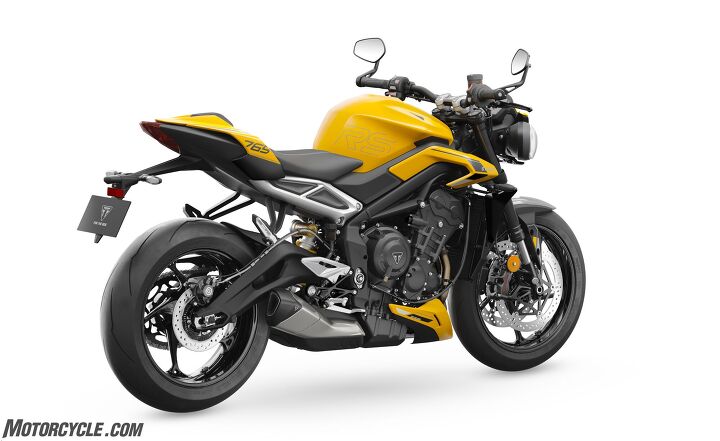
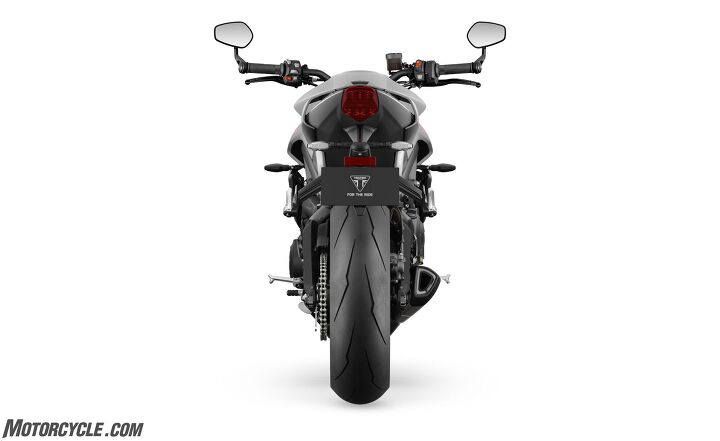
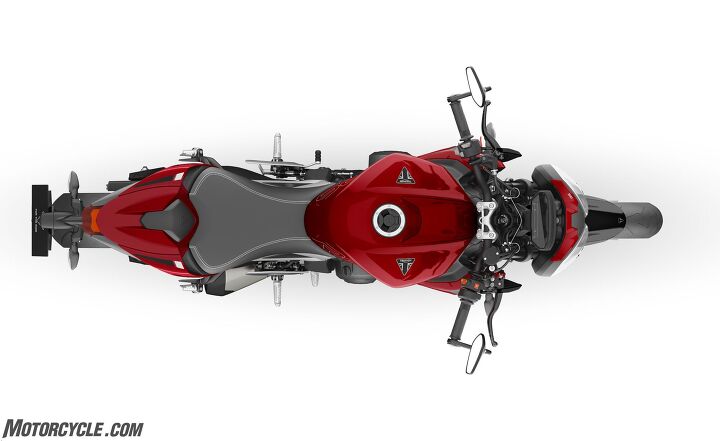
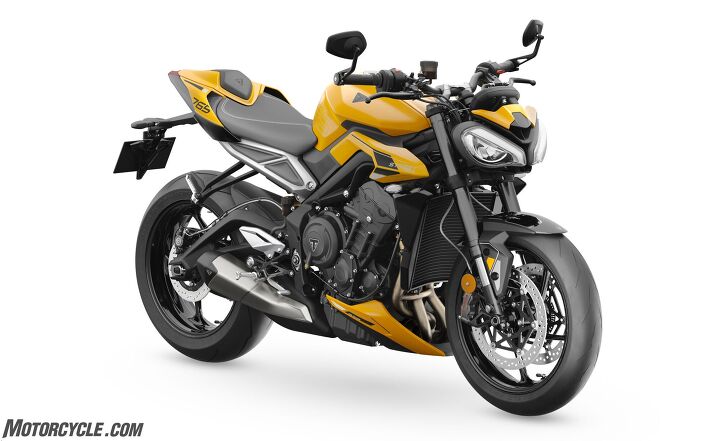
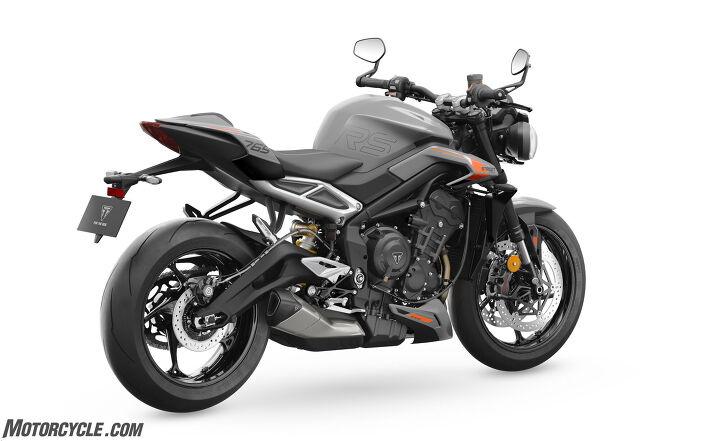

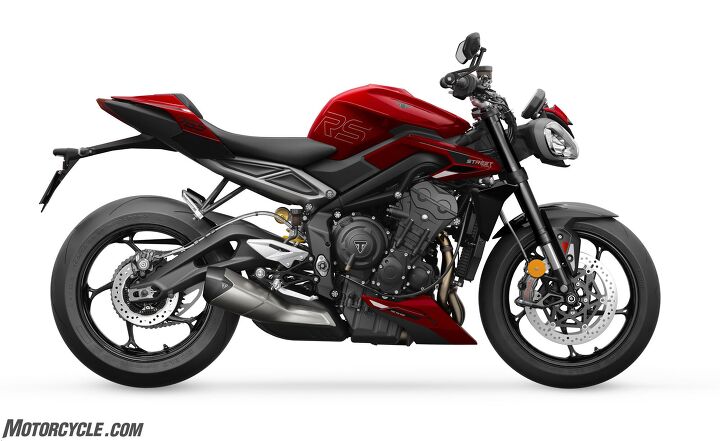
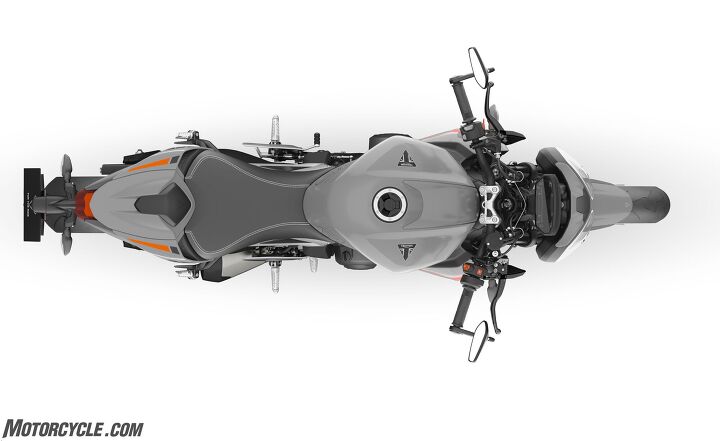
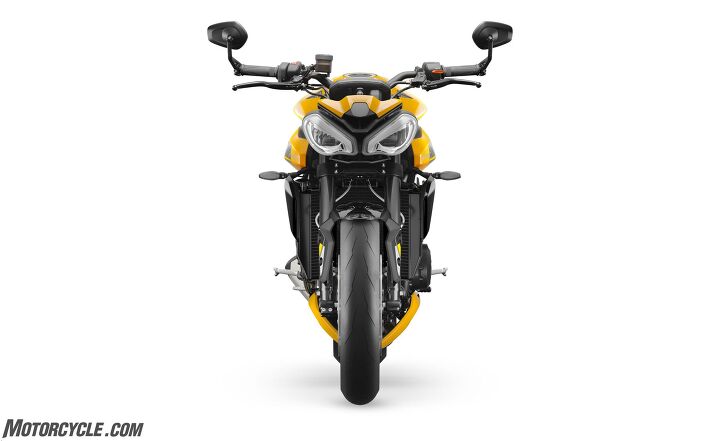
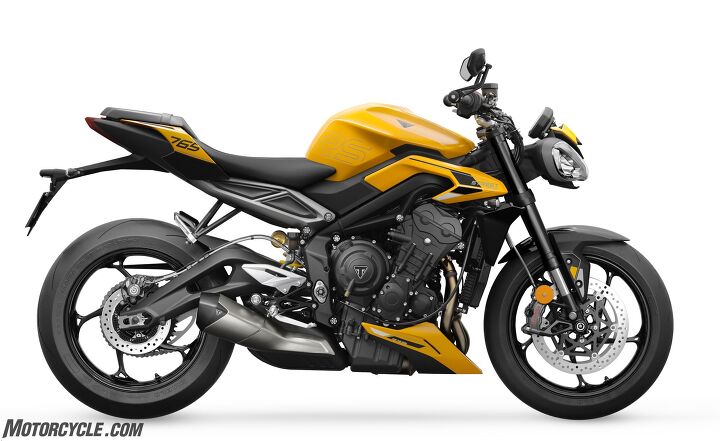
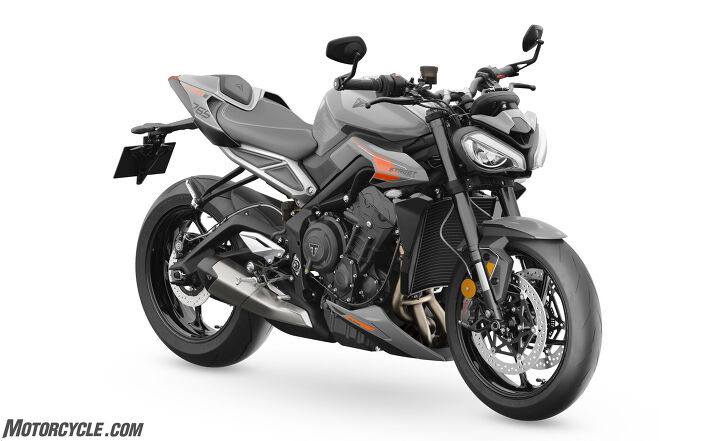
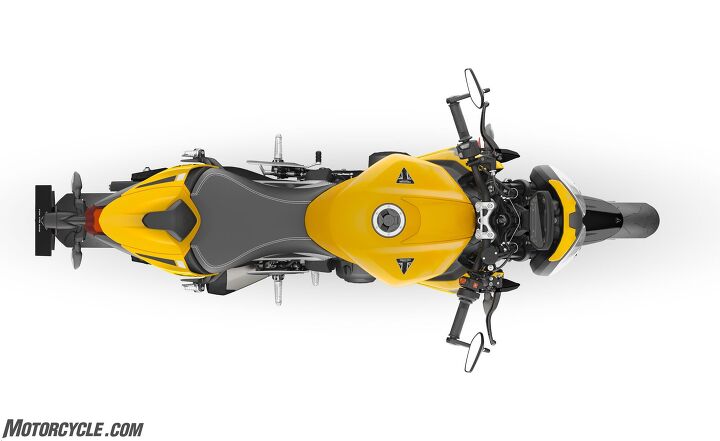
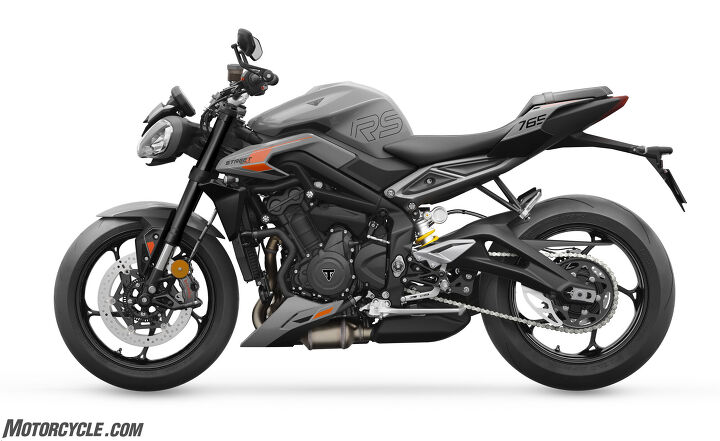

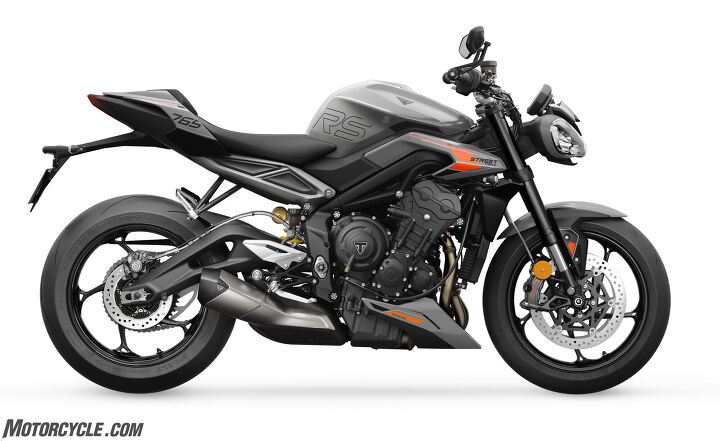
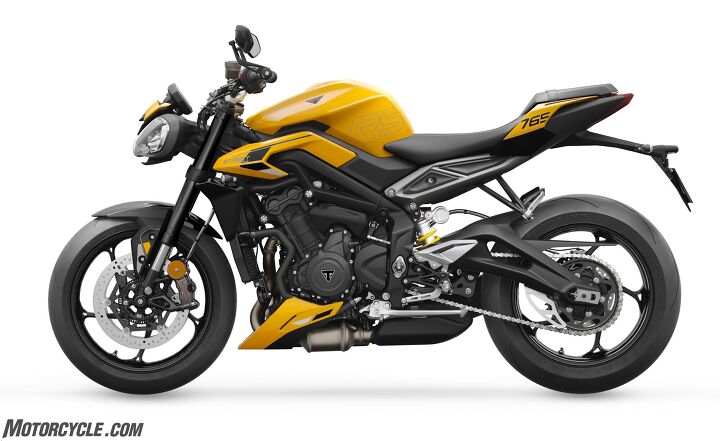
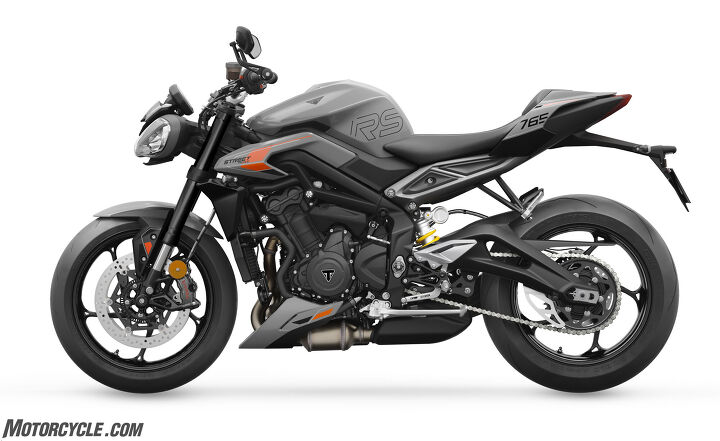
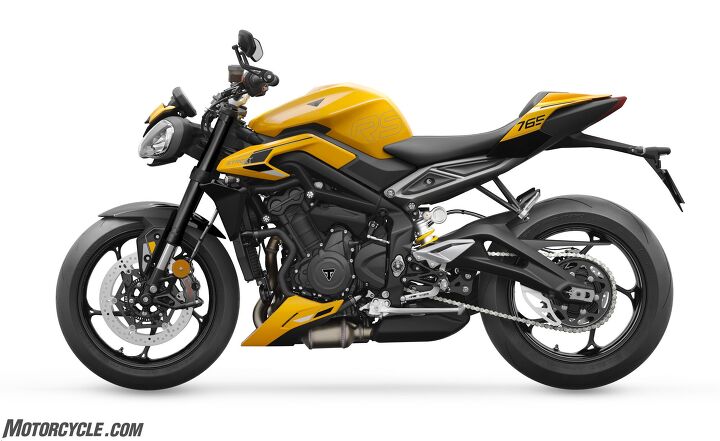
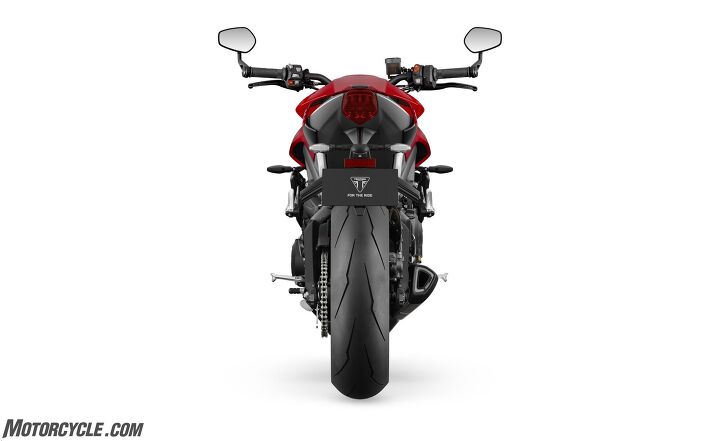
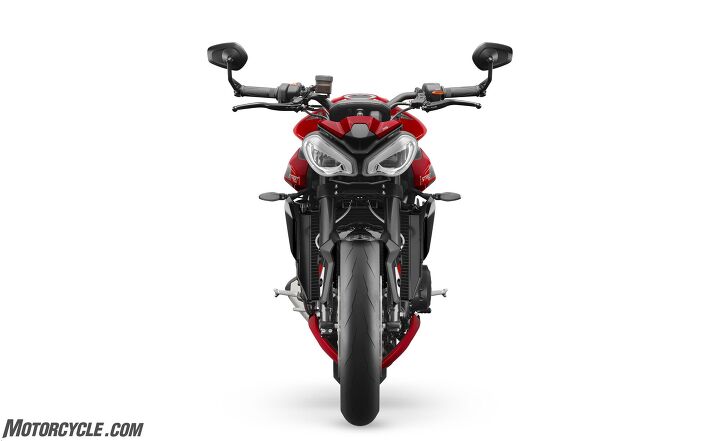
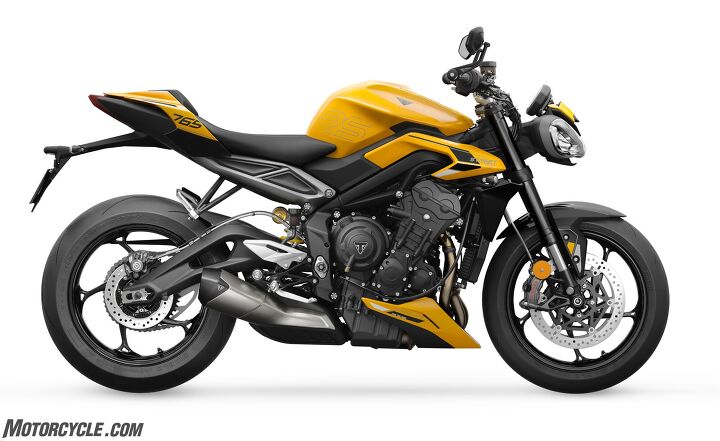
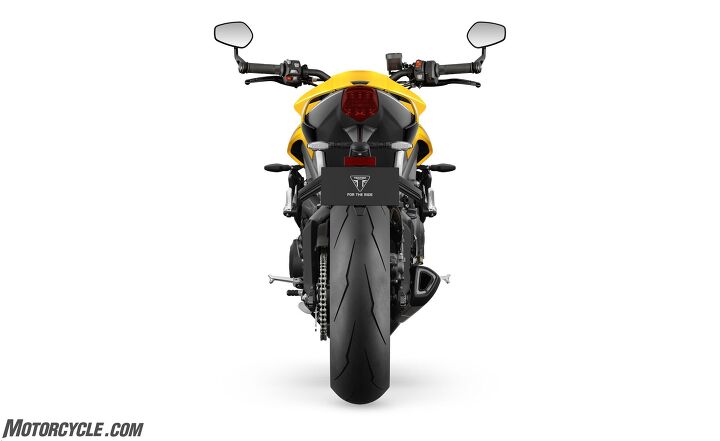
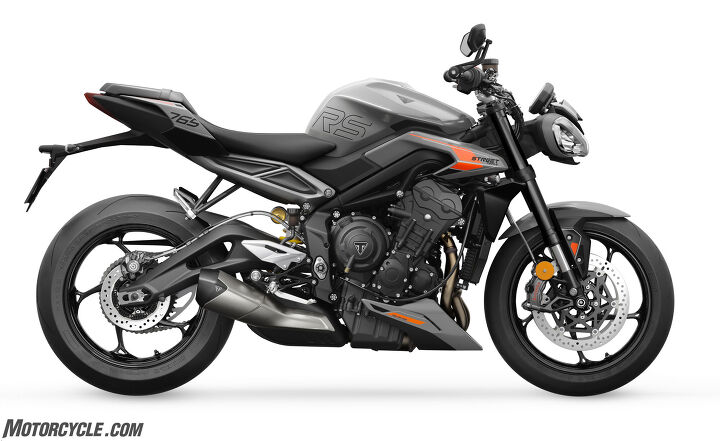
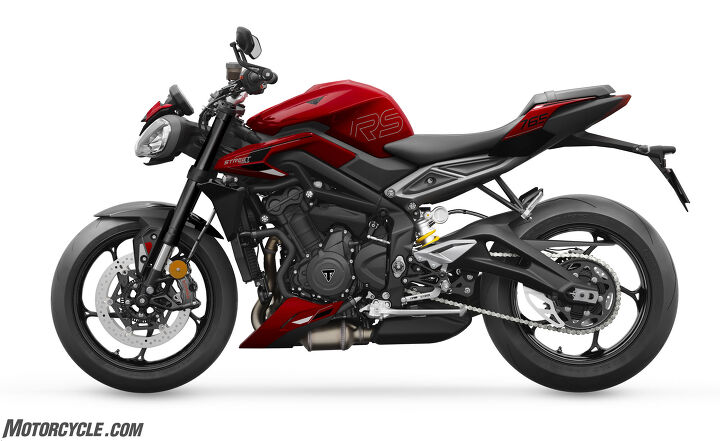
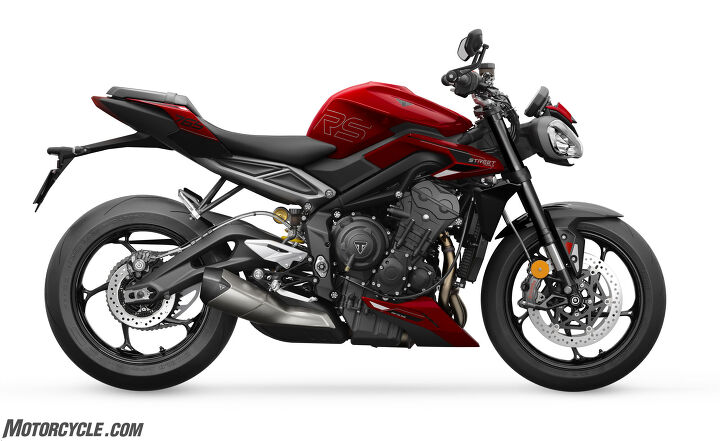
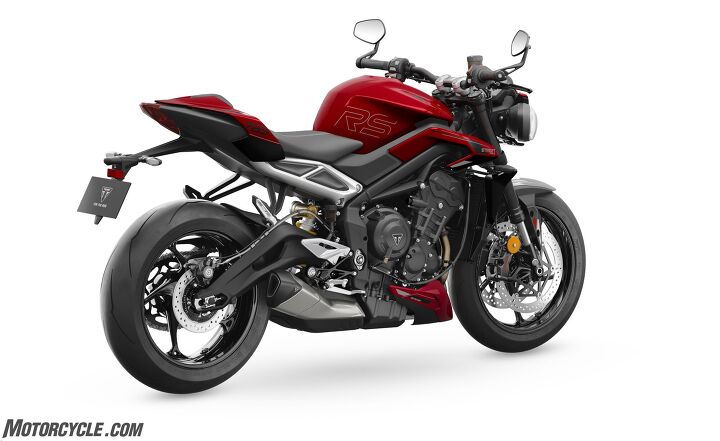
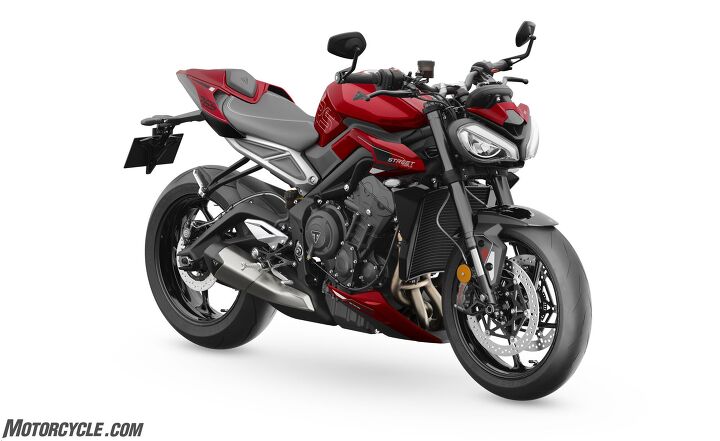
Street Triple 765 Moto2 Edition
Saving the best for last, we have the Street Triple 765 Moto2 Edition. Limited to just 765 examples of each of the two color schemes worldwide, Triumph is shamelessly leveraging its participation in the Moto2 championship with this one, and really, who can blame them? As such, you see Moto2 branding as part of the livery, but it also pops up on the 5-inch TFT dash each time the bike is started.
In reality, the Moto2 edition is largely the same as the RS model, except for two key differences. The first is the clip-on handlebars that are 3.149” lower and 1.97” further forward than the R and RS, giving the most aggressive and sporty seating position of the three bikes, by far. The second is the 43mm upside down, fully adjustable Öhlins NIX30 front fork to go with the STX Öhlins piggyback rear shock. Front wheel travel is 4.5 inches (115mm), with 5.2 inches (131.2mm) of rear wheel travel. The Moto2 rake angle of 23.0º and trail number of 3.75 inches (95.3mm) are even steeper and shorter than the RS for more track-focused performance.

The biggest difference between the Moto2 Edition and the rest of the Street Triples is the aggressive handlebar position that’s much lower and forward, placing the rider in attack mode.
Wood goes on to explain, “The triple clamps on the Street Triple R and RS are the same with the difference in geometry being achieved by having a higher rear ride height on the RS giving a steeper headstock angle and reduced trail. The Street Triple Moto2 Edition has its own triple clamps to allow the fitment of the 43mm diameter Öhlins NIX30 forks and the revised ergonomics clip-on handlebars. The yokes have the same offset as the R and RS but the suspension has its own set up including a stiffer front spring rate, giving the steeper rake and further reduced trail.
On both the RS and Moto2 Edition you’ll find Pirelli Diablo Supercorsa SP V3 tires as standard. We’ve used these tires a lot here at MO and are impressed with the racetrack levels of grip and outstanding high-speed stability, all from a fully road-legal tire.
As the ultimate, race-inspired Street Triple, the Moto2 Edition gets the carbon fiber treatment, with the front mudguard, side panels, headlight finisher, and belly pan all being made from the stuff. Adding to each Moto2’s exclusivity and desirability, these limited-edition motorcycles have an exquisitely machined top yoke with its number etched onto it. Just 765 of each color scheme will be made, making this the most exclusive, and collectible, Street Triple to date.
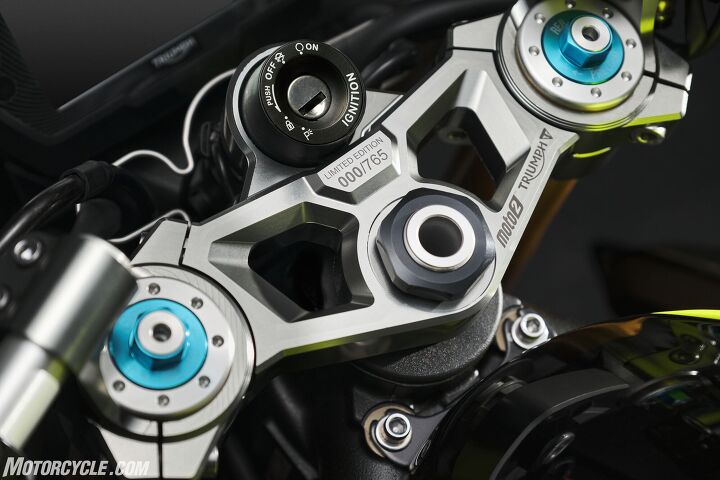
The Moto2 also gets Öhlins forks as well as an etched number on the triple clamp to signify which of the 765 units (of either color) you have.
Finally, the Moto2 Edition comes in two liveries: Triumph Racing Yellow with an Aluminum Silver rear sub-frame or Crystal White with Triumph Racing Yellow rear subframe. There’s also official Moto2 branding on the tank, wheel, tail unit, and silencer.
The Street Triple 765 Moto2 Edition starts at $15,395.
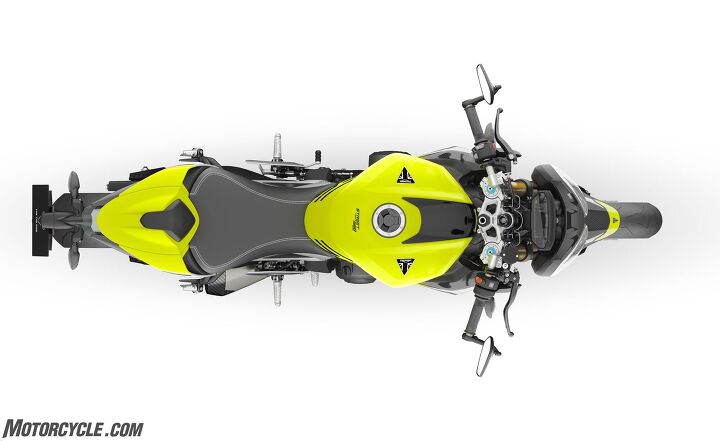
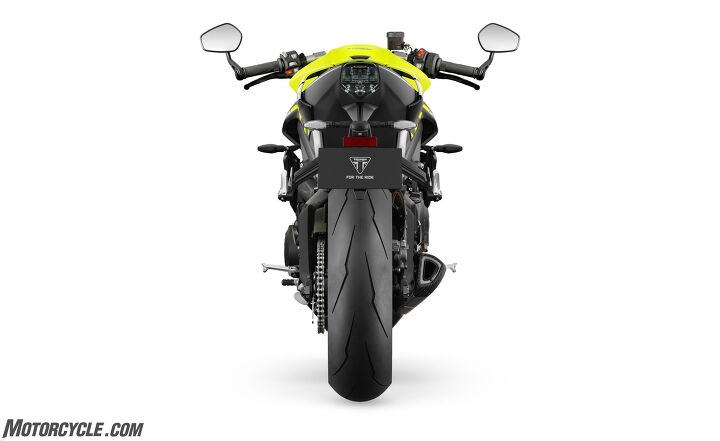
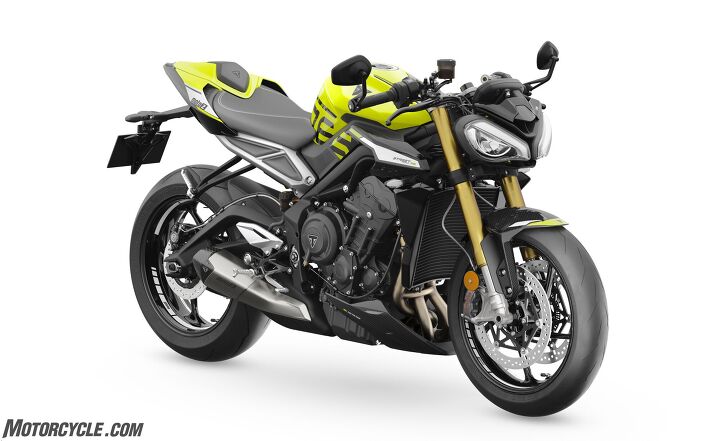
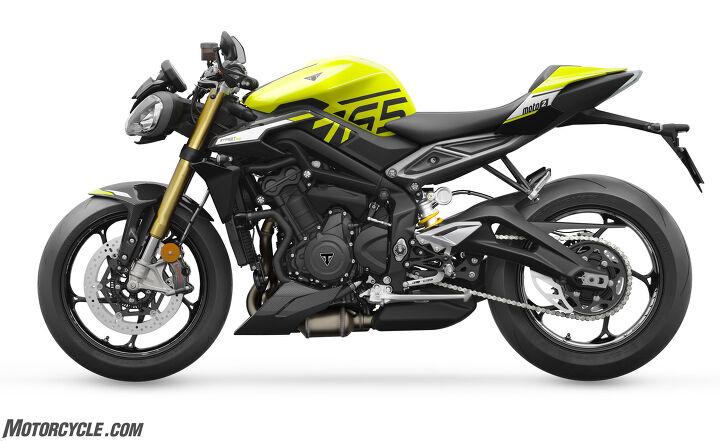
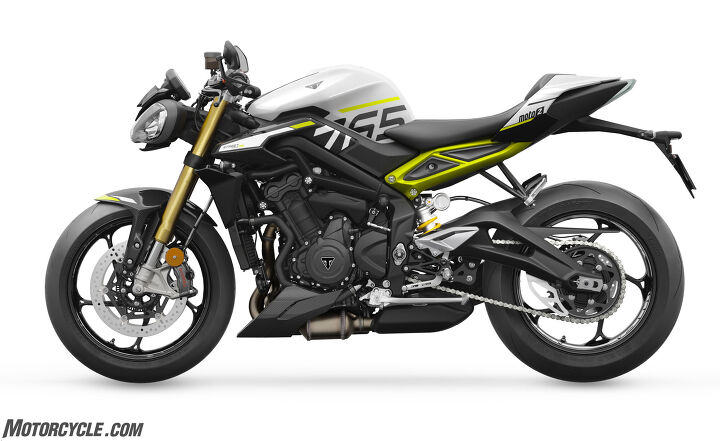
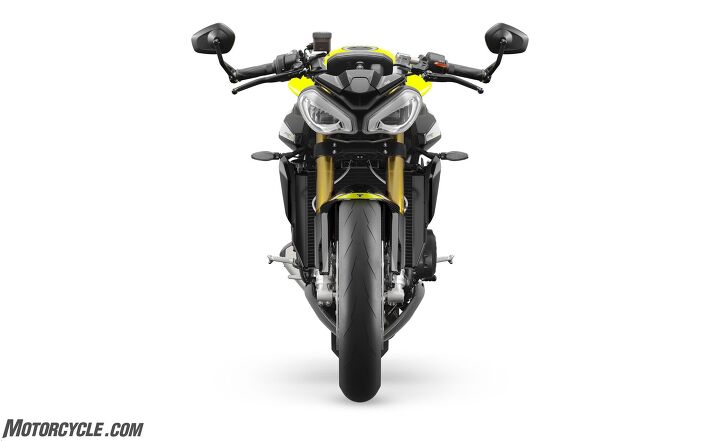
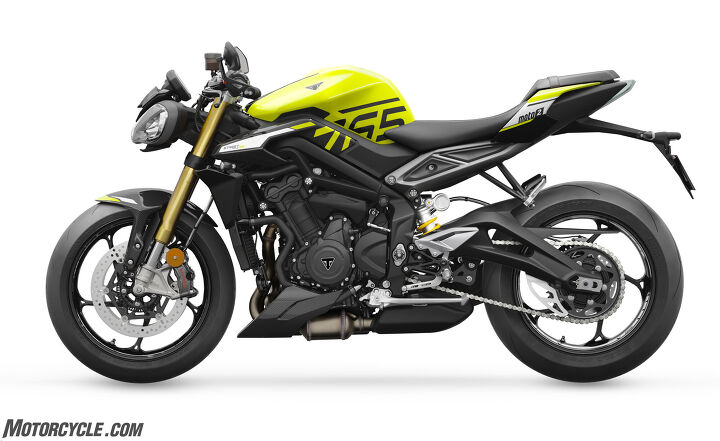
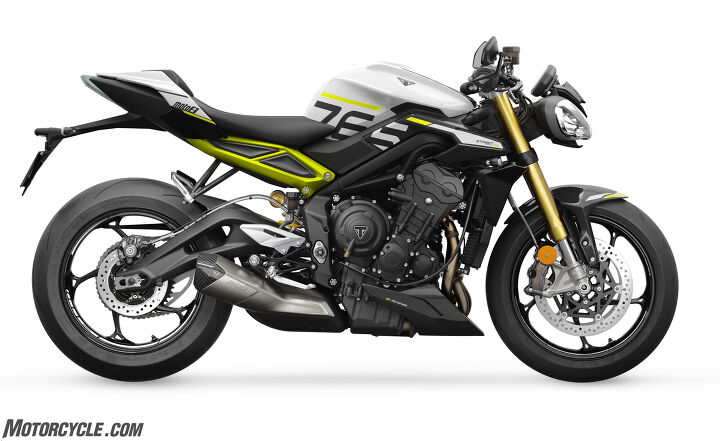
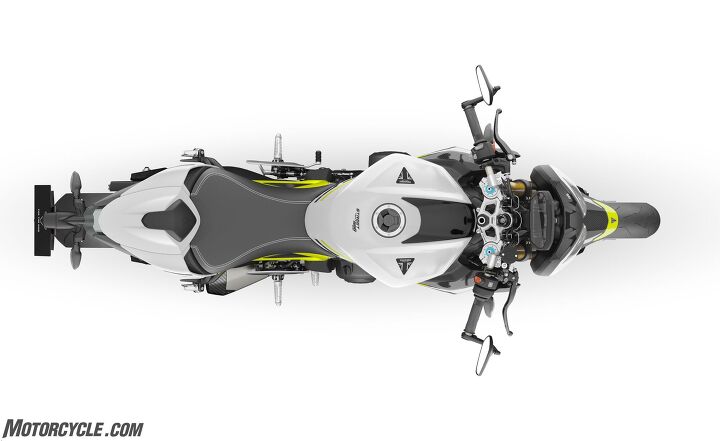
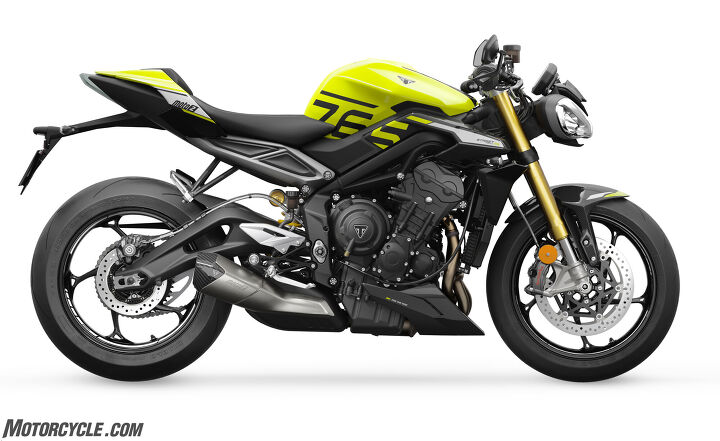
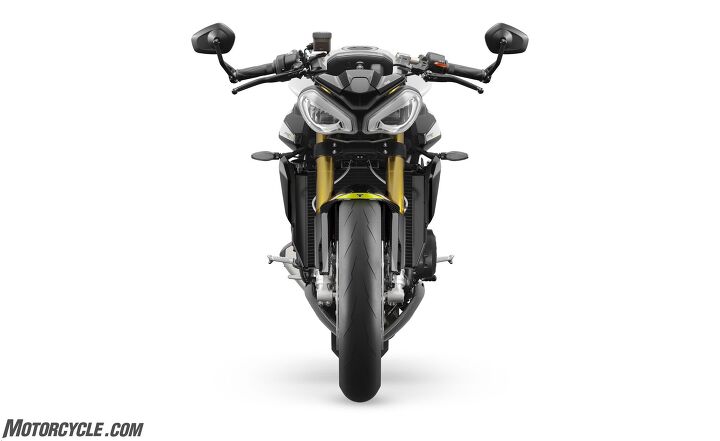
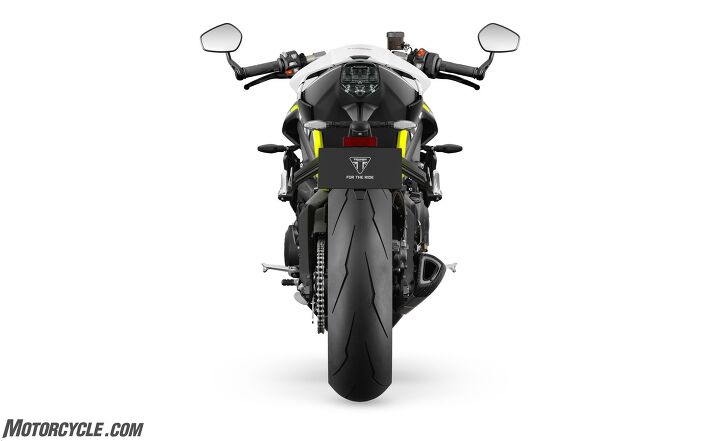
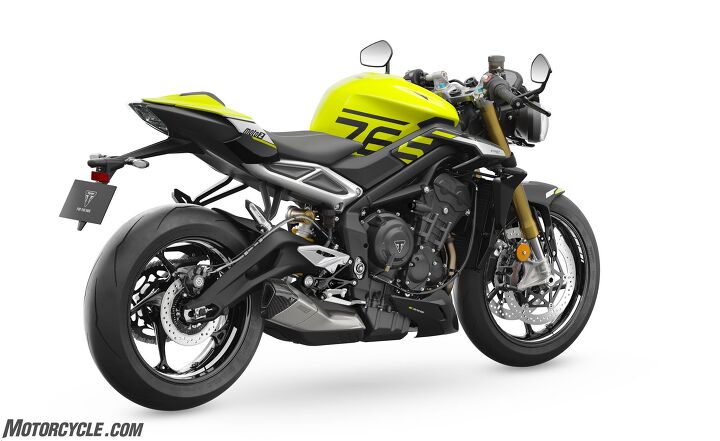
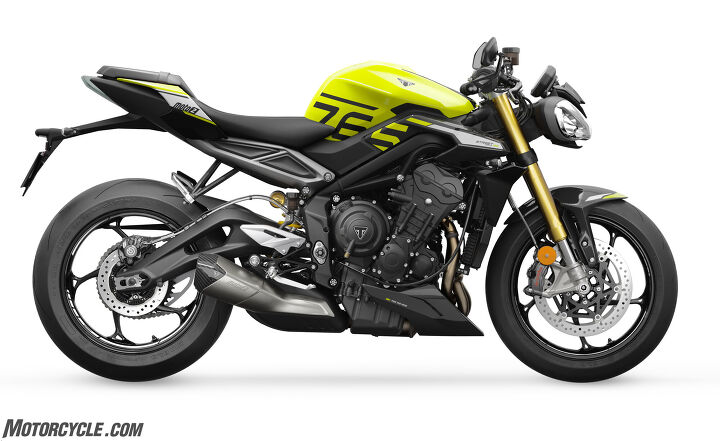
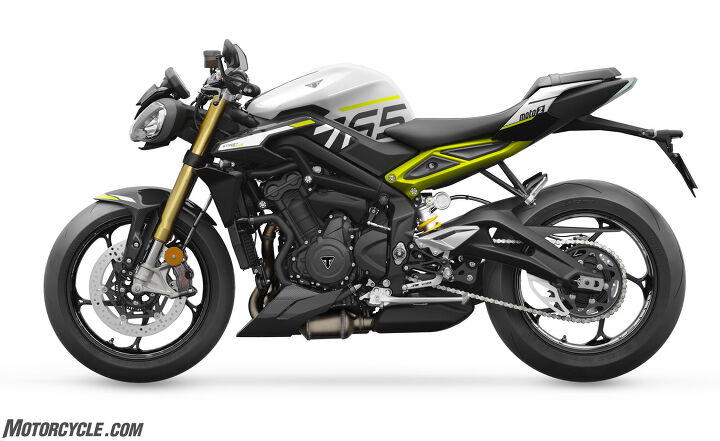
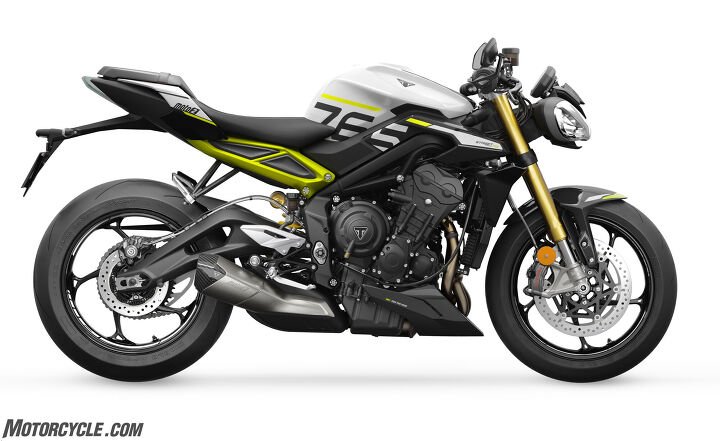
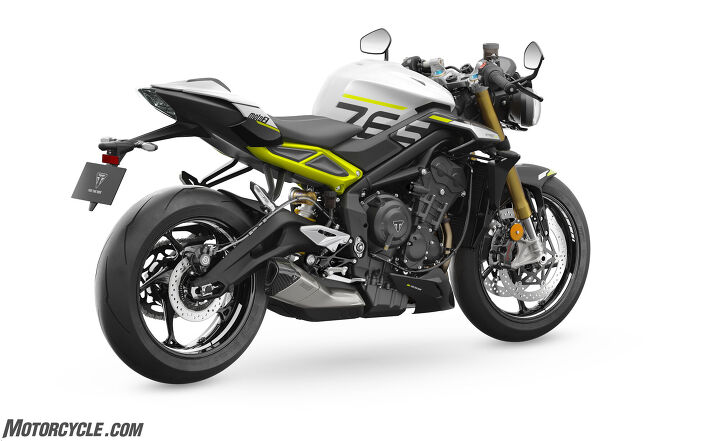
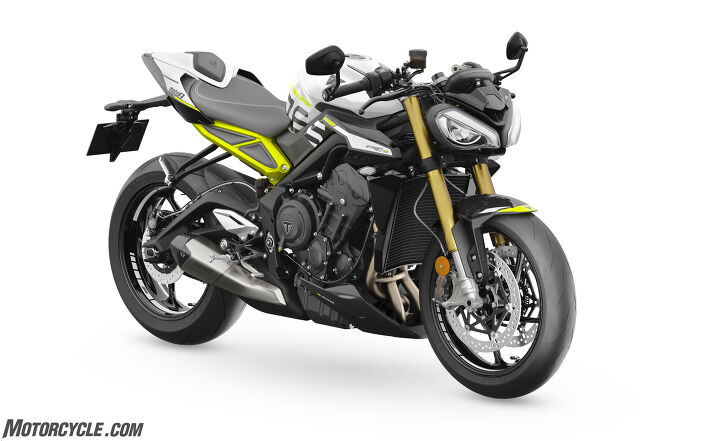
| 2023 Triumph Speed Triple Specifications | |||
|---|---|---|---|
| Street Triple R | Street Triple RS | Street Triple Moto2 Edition |
|
| Engine Type | Liquid-cooled, 12 valve, DOHC, inline 3-cylinder | ||
| Displacement | 765 cc | ||
| Bore x Stroke | 78.0 mm x 53.4 mm | ||
| Compression Ratio | 13.25:1 | ||
| Horsepower | 118 hp at 11,500 rpm (claimed) | 128 hp at 12,000 rpm (claimed) | 128 hp at 12,000 rpm (claimed) |
| Torque | 59 lb-ft. at 9,500 rpm (claimed) | ||
| Fuel System | Multipoint sequential electronic fuel injection with electronic throttle control | ||
| Exhaust | Stainless steel 3-into-1 header system with low single-sided stainless steel silencer | ||
| Final Drive | X-ring chain | ||
| Clutch | Wet, multi-plate, slip & assist | ||
| Gearbox | 6 speed | ||
| Frame | Aluminum beam twin spar frame with 2 piece high pressure die cast rear subframe | ||
| Swingarm | Twin-sided, cast aluminum alloy | ||
| Front Wheel | Cast aluminum alloy 5 spoke, 17 x 3.5 in | ||
| Rear Wheel | Cast aluminum alloy 5 spoke, 17 x 5.5 in | ||
| Front Tire | 120/70 ZR 17 | ||
| Rear Tire | 180/55 ZR 17 | ||
| Front Suspension | Showa 41 mm upside down Separate Function Forks – Big Piston (SFF-BP), adjustable compression and rebound damping, and preload adjustment. 4.5 inches of wheel travel | Showa 41 mm upside down Big Piston Forks (BPF), adjustable compression and rebound damping, and preload adjustment. 4.5 inches of wheel travel | Öhlins NIX30, adjustable compression and rebound damping, and preload adjustment. 4.5 inches of wheel travel |
| Rear Suspension | Showa piggyback reservoir monoshock, adjustable compression, rebound, and preload adjustment. 5.3 inches of travel | Öhlins STX40 piggyback reservoir monoshock, adjustable compression and rebound damping, and preload adjustment. 5.2 inches of travel | |
| Front Brakes | Twin 310 mm floating discs, Brembo M4.32 4-piston radial monobloc calipers, OC-ABS | Twin 310 mm floating discs, Brembo Stylema 4-piston radial monobloc calipers, OC-ABS, Brembo MCS radial master cylinder | |
| Rear Brakes | Single 220 mm disc, Brembo single piston caliper, OC-ABS | ||
| Instruments | Multi-function instruments with color TFT screen | Full-color 5″ TFT instruments | |
| Length | 80.91” (2055 mm) | 80.79” (2052 mm) | 80.75” (2051 mm) |
| Width | 31.18” (792 mm) | 31.18” (792 mm) | 30.12” (765 mm) |
| Height Without Mirrors | 41.22” (1047 mm) | 41.89” (1064 mm) | 41.38” (1051 mm) |
| Seat Height | 32.52” (826 mm) | 32.91” (836 mm) | 33.03” (839 mm) |
| Wheelbase | 55.20” (1402 mm) | 55.08” (1399 mm) | 55” (1397 mm) |
| Rake | 23.7° | 23.2° | 23.0° |
| Trail | 3.85” (97.8 mm) | 3.81” (96.9mm) | 3.75” (95.3 mm) |
| Wet Weight | 417 lb. (claimed) | 414 lb. (claimed) | 414 lb. (claimed) |
| Fuel Capacity | 3.96 gal (15 liters) | 3.96 gal (15 liters) | 3.96 gal (15 liters) |
| Service Interval | 6,000 miles (10,000km) / 12 months (whichever comes first) | ||
Become a Motorcycle.com insider. Get the latest motorcycle news first by subscribing to our newsletter here.
The post Triumph Announce New Street Triple Lineup For 2023 appeared first on Motorcycle.com.
Copyright
© Motorcycle.com


